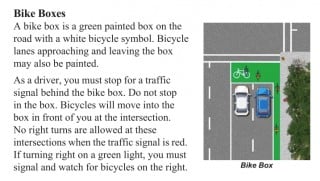We didn’t either.
Neither did Ray Thomas, the man who literally wrote the book on Oregon bike law (and has personally written and/or lobbied for many of them). Neither did Rob Sadowsky, the executive director of the largest bicycle advocacy organization in the state, or Noel Mickelberry, the leader of Oregon Walks.
“It caught us totally off guard,” Sadowsky shared with me this morning, “And it points to a lack of collaboration.”
This is a big deal because the 84-page Oregon Driver’s Manual impacts how people learn to behave on the road. It’s probably the one source of traffic law nearly every driver has consulted at least once and it’s used in court to justify behaviors both right and wrong. Making sure the driver’s manual presents information accurately and from a variety of perspectives — especially the most vulnerable road users — is a key component of the gradual march toward Vision Zero.
Suffice it to say I was surprised to get an email from Thomas about this last Friday (June 26th). After hearing about the revision in passing from a friend on a bike ride, he reached out local advocates wondering if anyone had been given the opportunity to weigh in on the process. Thomas was exasperated in his email because Friday the 26th was also the last day ODOT was accepting feedback.
Advertisement
“I only found out about the revision almost by accident and I am glad I did,” Thomas wrote, “because under Oregon law many judges allow the text of the Oregon Driver Manual into evidence against an injured vulnerable user.”
“I only found out about the revision almost by accident and I am glad I did… These Driver Manuals are used against my injured clients in court all the time.”
— Ray Thomas, lawyer
The manual is not intended to have any legal authority (it says so right on the opening page), but that doesn’t stop judges and even police officers from using it as such. “These Driver Manuals are used against my injured clients in court all the time,” Thomas cautioned.
Thankfully, Thomas got his comments in on time (no word yet whether his suggestions will be incorporated). Below is just a sampling of his feedback:
-p. 20 says “bike lane” is a “solid white line” – however in many intersections the bike lane is a broken white line which is intended to indicate a “mixing zone”.
-p. 24 under “passing” fails to indicate that a driver may drive on the left side in a no passing zone when an “obstruction or condition exists making it necessary” “provided that a driver doing so shall yield the right of way to all vehicles travelling in the proper direction….” ORS 811.420(3)(b).
-p. 26. “Passing on the Right”. This section should include reference to ORS 811.415 (2)(c) which states that “overtaking and passing on the right is permitted if the overtaking vehicle is a bicycle that may safely make the passage under the existing conditions.”
– p. 29 and 30 “Turns” should state “You may turn across a bicycle lane after yielding the right of way. Do not move into a bicycle lane in preparation for a turn. Always check your mirrors and over your shoulder before turning, and if you don’t know, don’t go. You must also stop for pedestrians and bicyclists in crosswalks and yield to pedestrians and bicyclists on sidewalks.”
– p. 38 the manual includes this sentence: “Inexperienced bicyclists can be unpredictable.” It should be changed to, “You may not be able to predict a bicyclist’s intentions.”
I followed up with ODOT to find out more about their process for revising the manual. DMV spokesman David House said they treat it like any other publication update and don’t have a formal public comment period. “But we consider suggestions from the public, lawmakers, etc.,” he said.
When I asked him specifically who had reviewed the manual this time around he said it was a mix of staff from the DMV, ODOT’s Safety Division, law enforcement officials, and staff from other divisions within ODOT.
House added that they’ll accept feedback from the public at any time and will consider it “in the next review.” The best way to share your comments and suggestions, House advised, is to “use the contact information links on OregonDMV.com.”
I can appreciate that ODOT updates a lot of publications and that a formal public process for each of them could be cumbersome. But I think they need to slow down a bit and consider getting more feedback and perspectives on the Driver’s Manual — especially at a time when the public is clamoring for Vision Zero, traffic fatalities are up over 43% so far this year and we know that many people have complete disregard for safety and the law when they get behind the wheel.
The new version of the manual — which will hopefully include Ray Thomas’s suggestions — should start appearing at your local DMV by January 2016.
To see the current draft ODOT staff is currently revising, download this PDF.


